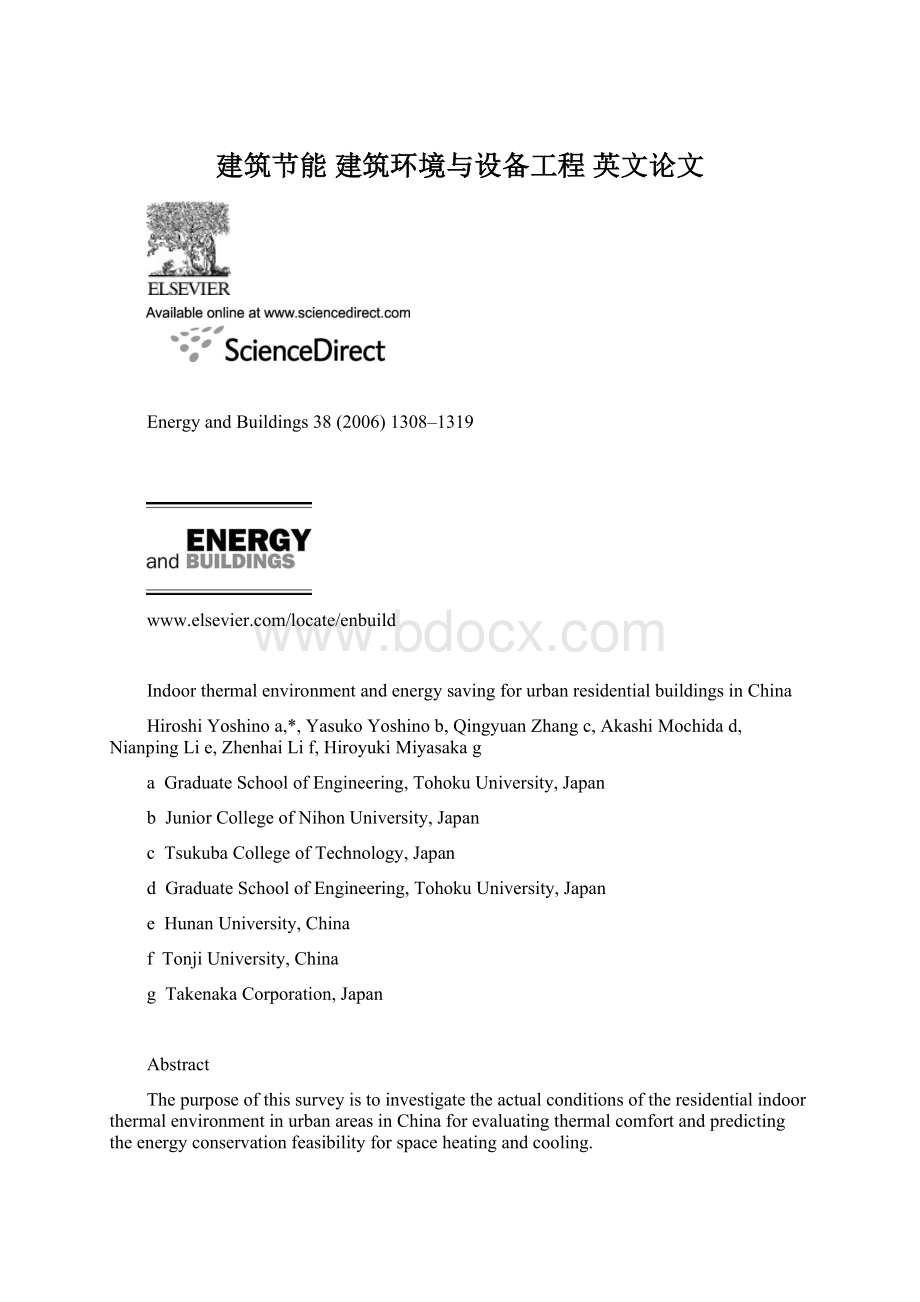建筑节能 建筑环境与设备工程 英文论文.docx
《建筑节能 建筑环境与设备工程 英文论文.docx》由会员分享,可在线阅读,更多相关《建筑节能 建筑环境与设备工程 英文论文.docx(28页珍藏版)》请在冰豆网上搜索。

建筑节能建筑环境与设备工程英文论文
EnergyandBuildings38(2006)1308–1319
IndoorthermalenvironmentandenergysavingforurbanresidentialbuildingsinChina
HiroshiYoshinoa,*,YasukoYoshinob,QingyuanZhangc,AkashiMochidad,NianpingLie,ZhenhaiLif,HiroyukiMiyasakag
aGraduateSchoolofEngineering,TohokuUniversity,Japan
bJuniorCollegeofNihonUniversity,Japan
cTsukubaCollegeofTechnology,Japan
dGraduateSchoolofEngineering,TohokuUniversity,Japan
eHunanUniversity,China
fTonjiUniversity,China
gTakenakaCorporation,Japan
Abstract
ThepurposeofthissurveyistoinvestigatetheactualconditionsoftheresidentialindoorthermalenvironmentinurbanareasinChinaforevaluatingthermalcomfortandpredictingtheenergyconservationfeasibilityforspaceheatingandcooling.
Theapartmenthomesunderinvestigationwerelocatedintheurbanareasofninemajorcities.Thequestionnairesurveyrevealedbuildingcharacteristics,thetypesofspaceheatingandcoolingsysteminuse,aspectsoflifestyle,duringwinterandsummerseasons,andsoon.ThemeasurementshowedthatwinterindoortemperaturesinHarbin,Urumqi,BeijingandXi’anremainatarelativelystablelevelnear208Cduetothecentralheatingsysteminstalled.Howeverintheothercitieslackingcentralheatingsystems,indoortemperaturesfluctuatedasafunctionofthechangeofoutdoortemperature.Ontheotherhand,summerindooreveningtemperaturesinShanghai,Changsha,ChongqingandHongKongwerehigherthanthecomfortzoneofASHRAE.ThereforeitisexpectedthatenergyuseforspaceheatingandcoolinginthesouthernChinawillincreaseinthenearfuturebecauseofoccupants’requirementforcomfortableindoorenvironment.Basedontheresultsyieldedbythisstudy,inBeijingthecalculationofspaceheatingandcoolingloadsindicatedthattheenergyusedtoheatindoorspacescanbehalvedbyinstallingthermalinsulationandproperlysealingthebuilding.
#2006ElsevierB.V.Allrightsreserved.
Keywords:
China;Residentialbuilding;Fieldmeasurement;Questionnairesurvey;Indoorthermalenvironment
1.Introduction
EnergyconsumptioninChinahasbeenincreasingrapidlyduetorecenteconomicgrowthanddevelopment.Thisleadstoseriousenvironmentalproblemssuchasglobalwarming,airpollutionandacidrain.Inresidentialbuildingsofdevelopedcountries,energyconsumptionforspaceheatingandcoolingisalargeinthetotalresidentialenergyconsumption.
InordertoestimatethefuturetrendofresidentialenergyconsumptionandindoorenvironmentrequirementinChina,itisnecessarytoknowthesituationoftheusageofhouseholdequipment,andtheindoorthermalconditions.Thepurposeofthisstudyistoinvestigatetheactualconditionsofindoor
*Correspondingauthor.Tel.:
+81222177883;fax:
+81222177886.
E-mailaddress:
yoshino@sabine.pln.archi.tohoku.ac.jp(H.Yoshino).
0378-7788/$–seefrontmatter#2006ElsevierB.V.Allrightsreserved.doi:
10.1016/j.enbuild.2006.04.006
environmentinurbandwellingsofChina.Inaddition,energyconservationpossibilitiesthroughthermalinsulationarediscussed.
InexistingresearchonresidentialenergyandindoorenvironmentinChina,Liu[1]reviewsthedeterminantsofenergydemandandsaturationofhouseholdequipmentinChina.Brockettetal.[2]reporttheinvestigationresultsofresidentialenergyconsumptioninfivecities.AndJianandJiang[3]investigatedindoorthermalenvironmentofapartmentunitsduringthesummerinBeijing.ButthecurrentbodyofresearchlacksadetailedinvestigationoftherelationshipbetweentheuseofspaceheatingandcoolingequipmentandindoortemperatureandhumiditylevelsinvariousChinesecities.Ontheotherhand,forJapaneseresidentialbuildings,Bogaki,Yoshinoetal.[4]reportmeasurementresultsonindoortemperatureduringthewinterandsummerof350housingunits.Theresultsoftheirresearchexhibitdistinguished
H.Yoshinoetal./EnergyandBuildings38(2006)1308–13191309
differencesofindoortemperaturesbetweenHokkaidoandotherregions.Hasegawa,Yoshinoetal.[5]reportwinterindoortemperaturesofresidentialbuildingsinthenorthernregionofJapan.Theyinvestigatedaround900housesin14citiesineachyearof1982,1992and2002toclarifybuildingperformancetreads,housingequipment,indoortemperatures,energyuseforspaceheating,etc.Theyreportedthatthemeanindoortemperatureatnightineachcityincreased108Cinthe20yearperiod.Alsoitwasreportedthattheindoortemperaturemeasuredin2002incoldercitywasabout208Candthatinmildcitywaslessthan158C.
Thispaperwascompiledandanalyzedbasedonliteratures[6–8]forthewinterinvestigationand[9,10]forthesummerinvestigation.
2.Indoorthermalenvironment
2.1.Locationofthecitiesformeasurement
TheapartmenthousesunderinvestigationwerelocatedintheurbanareasofHarbin,Urumqi,Beijing,Xi’an,Shanghai,Changsha,Chongqing,KunmingandHongKong.ThesearemajorcitiesinChina,whicharerepresentativeofeachclimaticregionshownasFig.1[11].Fig.2showstheclimograph[12]ofeightcitiesforinvestigationinChina.
Thesecitieshavesignificantdifferentclimaticconditions.
2.2.Methodsofinvestigation
2.2.1.Questionnaireapproach
Ineachcity,questionnairesandliquidcrystalthermometersweredistributedto36–120participatingfamiliesselectedbythelocalresearchers.InthecasesofShanghai(1998),BeijingandHarbin,materialsforinvestigationweredistributedtopupilsofelementaryandhighschoolswhowererequestedtoasktheirparentsmakinganswers.InShanghai,halfthepupilslivedinagingcityareasandtheotherhalflivedinnewcityareas.Inothercities,localresearchersaskedforthecooperationoftheircolleaguesandstudentsaswellas
Fig.1.Locationofthecitiesformeasurement.
Fig.2.ComparisonoftheclimographsofmajarcitiesinChina.
relativesandacquaintancesofthecolleaguesandstudents.Exceptforthreecities,thesubjectsbelongedtorelativelymiddletohighclasssocietyinChina.InShanghai,thesummerinvestigationwascarriedouttwicein1998(Shanghai’98)and
2003(Shanghai’03).Occupantsofthesehouseswereaskedtoansweraquestionnaire,whichascertainedbasicinformationregardingtheirbuildings,heatingperiod,operationtimeduringaday,clothing,useofheatingequipmentsandthermalsensation.Table1showsthecontentsofquestionnaire.Aquestionnairecreatedforapreviousstudy[5]inJapanwasusedasamodel.Energyconsumptiondatawassoughtbythequestionnaire,howeverdataprovidedbytherespondentswasnotsufficientforanalysis.Inaddition,twoliquidcrystalthermometersweregiventoeachhome,oneforlivingroomandoneforbedroom,tomeasuretheindoortemperature.Theoccupantswereaskedtorecordthetemperaturesoflivingroomandbedroomthreetimesadayfor5days,i.e.morning(6.00a.m.–8.00a.m.),daytime(11.00a.m.–1.00p.m.)andeve-ning(7.00p.m.–9.00p.m.).Outofthehousesconsideredforquestionnairesurvey,afewweretakenupforfieldmeasure-mentoveraperiodof5days,whichissameasthesurveyperiodforthatparticularcity.
2.2.2.Fieldmeasurementapproach
Indoortemperatureandhumidityweremeasuredbysmalldataloggerswithsensors,whichwereplacedinthebedroom,
Table1
Contentsofquestionnaire
BuildingcharacteristicConstructionyear,structure,floorareas,windows,conditionofbalcony
HousingequipmentHeatingandcollingsystem,ventilationsystem,equipmentofhot-watersupply
ResidentialcharacteristicNumberofoccupants,income
LifestyleHeatingandcollingperiod,heatingandcollingtime,garmentinsulationvalue
SatisfactionratingSatisfactionofthethermalcomfortandresidentialenvironment
EnergyconsumptionConsumptionofcitygasandelectricity
IndoorthermalenvironmentTemperatureinthemorning,daytimeandevening
1310
H.Yoshinoetal./EnergyandBuildings38(2006)1308–1319
Table2
Subjecthousesofthesurveyinwinter
CitySurveyperiodNumberofhousesforquestionnaire
Numberofhousesformeasurement
HeatingsystemAverageoutdoorconditionsduringinvestigation
Winter
Harbin3/2000995Centralheating5.98C,65.4%RHaUrumqi1/200410010Centralheating12.18C,66.8%RHbBeijing1/1999363Centralheating3.48C,39%RHaXi’an1/200210010Centralheating5.18C,72%RHbShanghai1/1998746Individualspaceheating9.28C,76%RHaChangsha1/200310010Individualspaceheating4.08C,81.6%RHbChongqing1/20039710Individualspaceheating10.18C,87.6%RHbKunming1/200410110Individualspaceheating11.08C,56.3%RHbHongKong1/200210312Individualspaceheating19.18C,54%RHbTotal81076
aBasedonlocalmeteorologicaldata.
bBasedonthemeasurement.
livingroom(ataheightof1.1mfromthefloorlevel)andoutdoor(northsideofthebuildingshadedfromthesun).
2.3.Winterinvestigation
2.3.1.Subjecthousesofthesurveyinwinter
Table2showsthenumberofsubjecthomes,heatingsystemandoutdoorclimateconditionsduringinvestigation.
Thequestionnairesurveytogetherwiththemeasurementsofindoortemperatureandhumidityweredoneinthewinterof
1998forShanghai,1999forBeijing,2000forHarbin,2002for
Xi’anandHongKong,2003forChangshaandChongqing,
2004forUrumqiandKunmings.
2.3.2.Resultsofquestionnaireinvestigation
2.3.2.1.Constructionyearofbuildings(Fig.3).Intheseninecities,mostofthebuildingsinvestigatedwereconstructedinthe
90s,exceptforChongqing.InChongqing,mostofthebuildingsinvesti